International experience in building the legal mechanism for prevention and combat against human trafficking: lessons for Vietnam
At present, human trafficking is becoming very complicated. This is not only
a matter of every nation, every region, but also an international problem. This requires each
country to formulate effective and consistent legal mechanisms in line with international
regulations in the fight against human trafficking crimes. The study of experiences of countries,
including countries closely related to the situation of human trafficking in Vietnam such as
China, the Philippines and Thailand, is a reference channel for Vietnam to complete and
improve the legal mechanism to prevent and combat human trafficking in the coming time
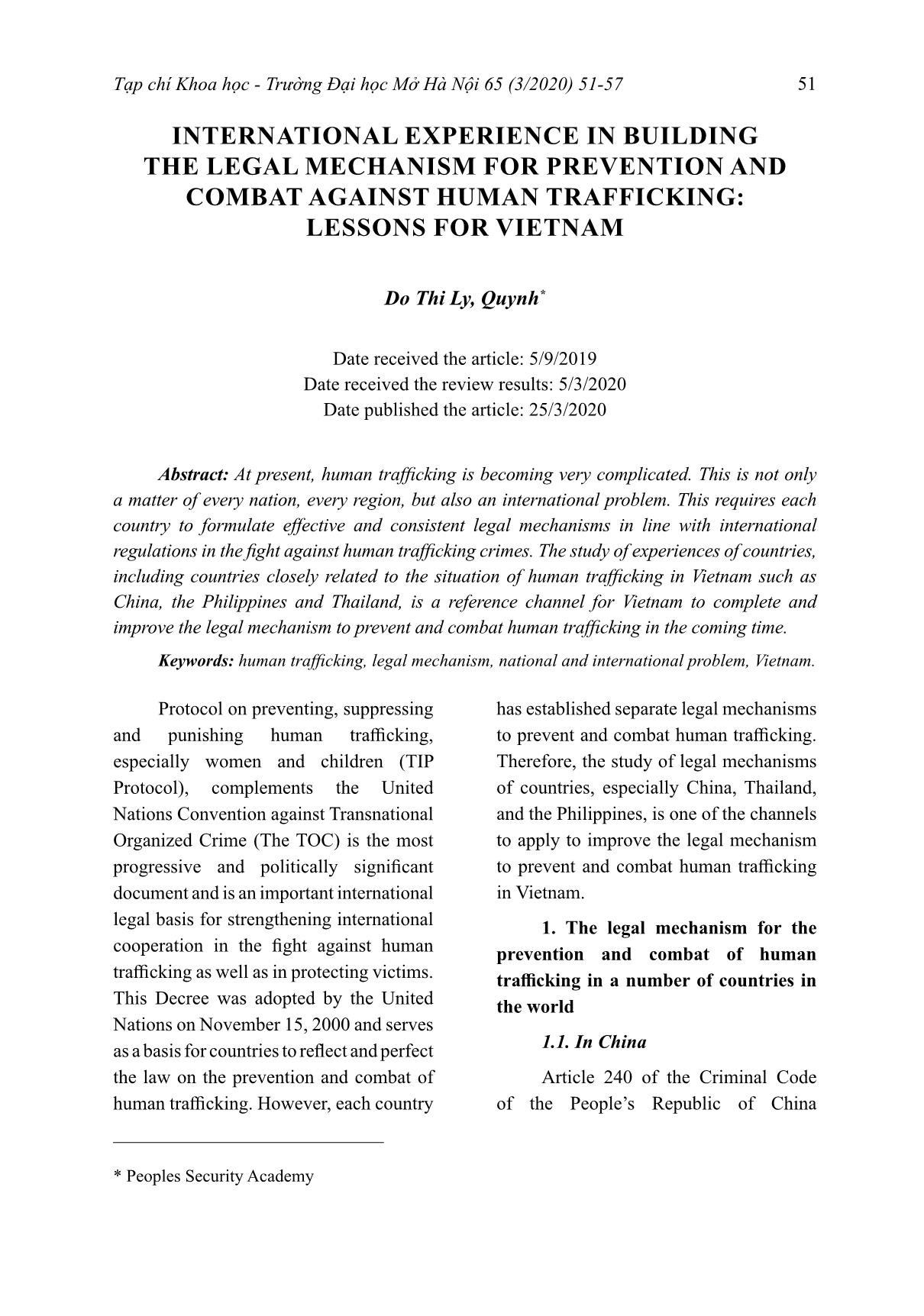
Trang 1
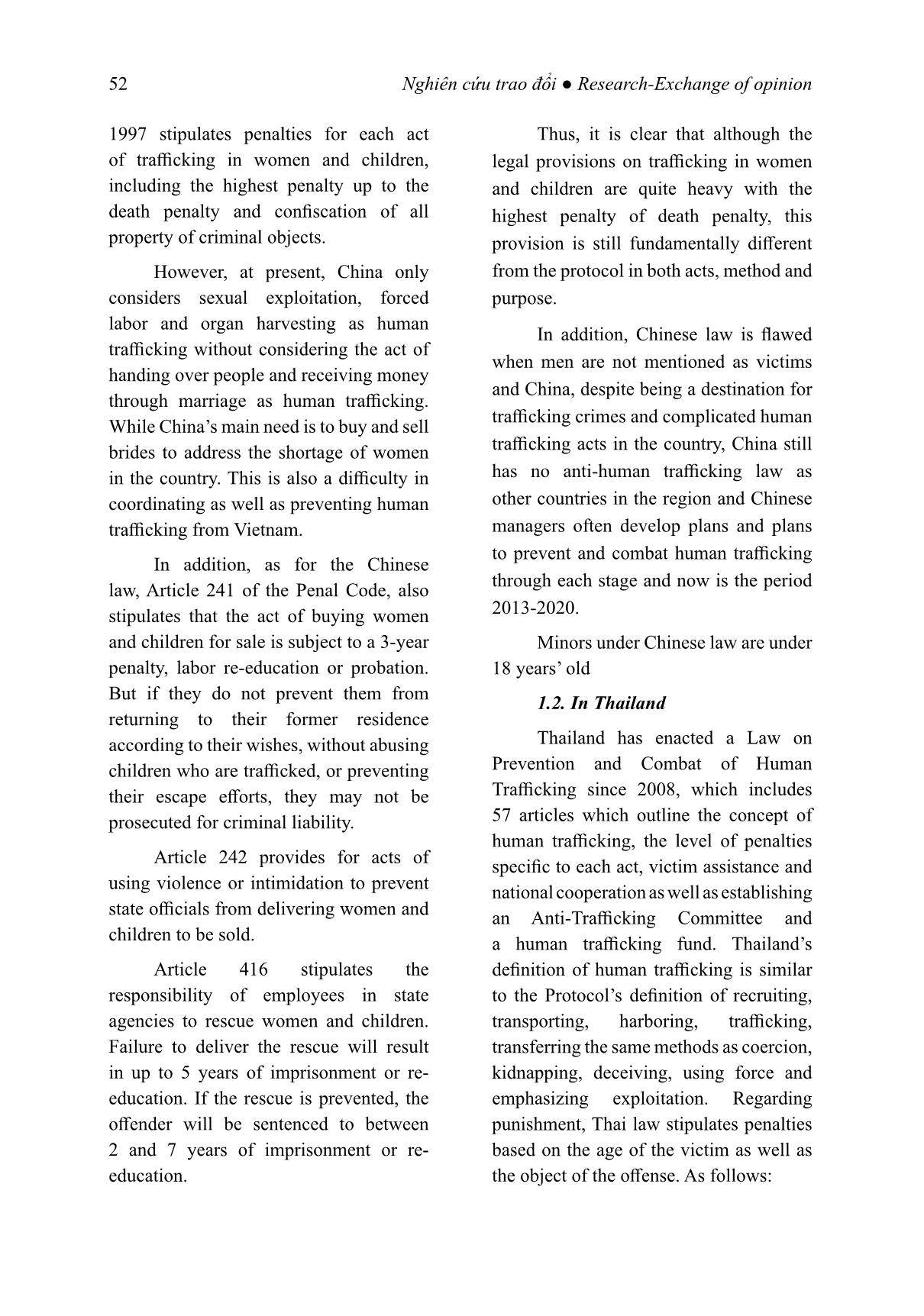
Trang 2
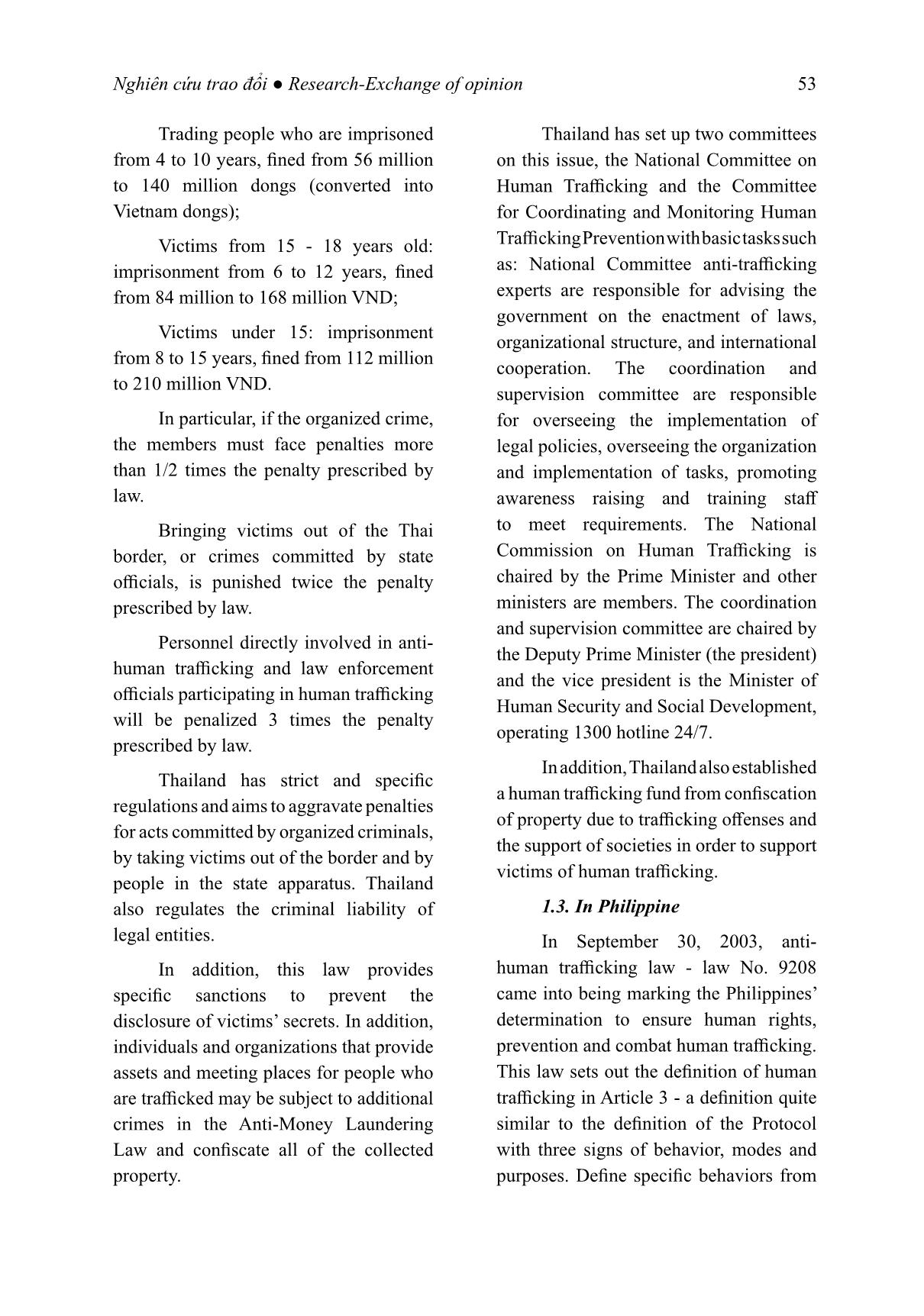
Trang 3
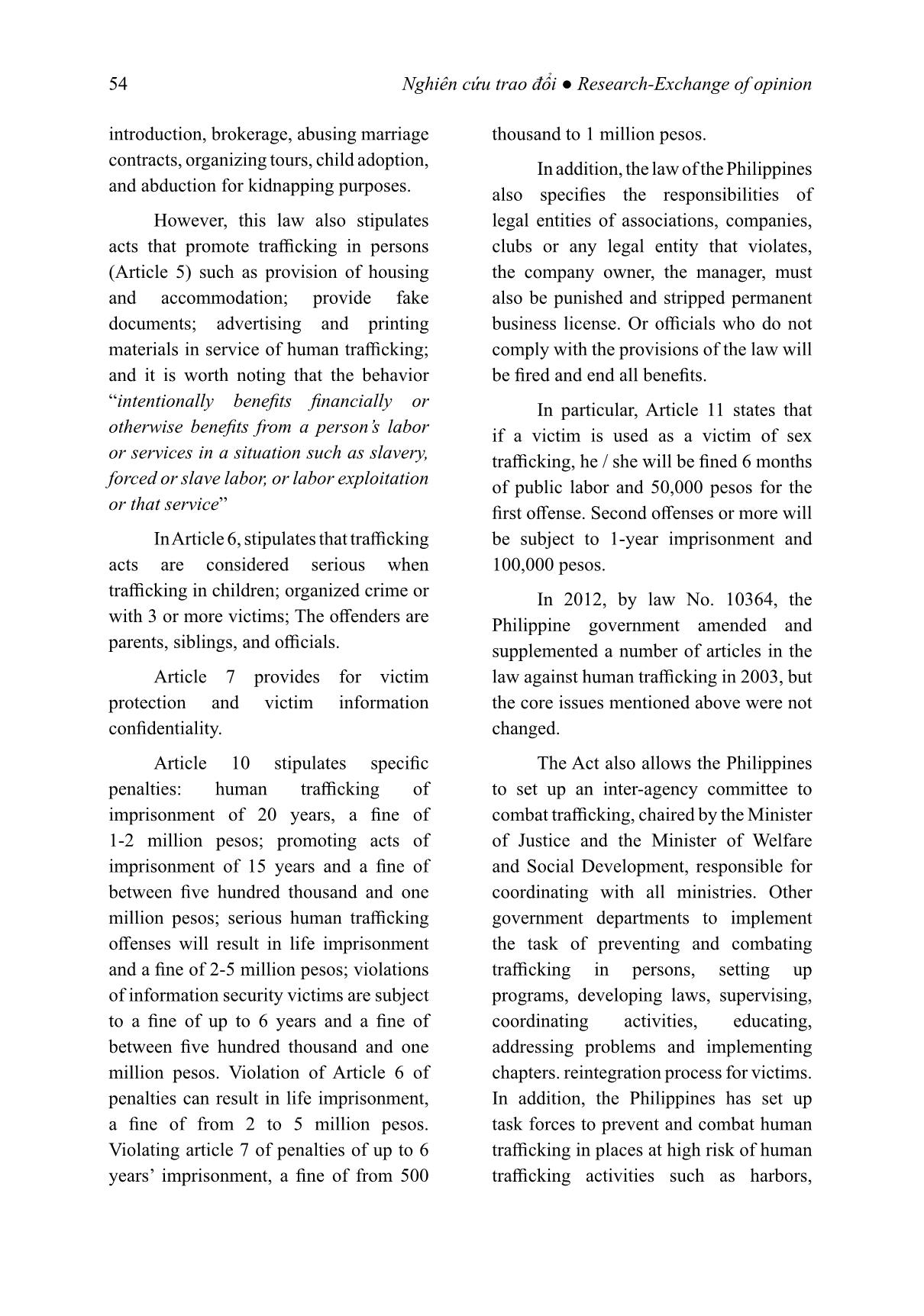
Trang 4
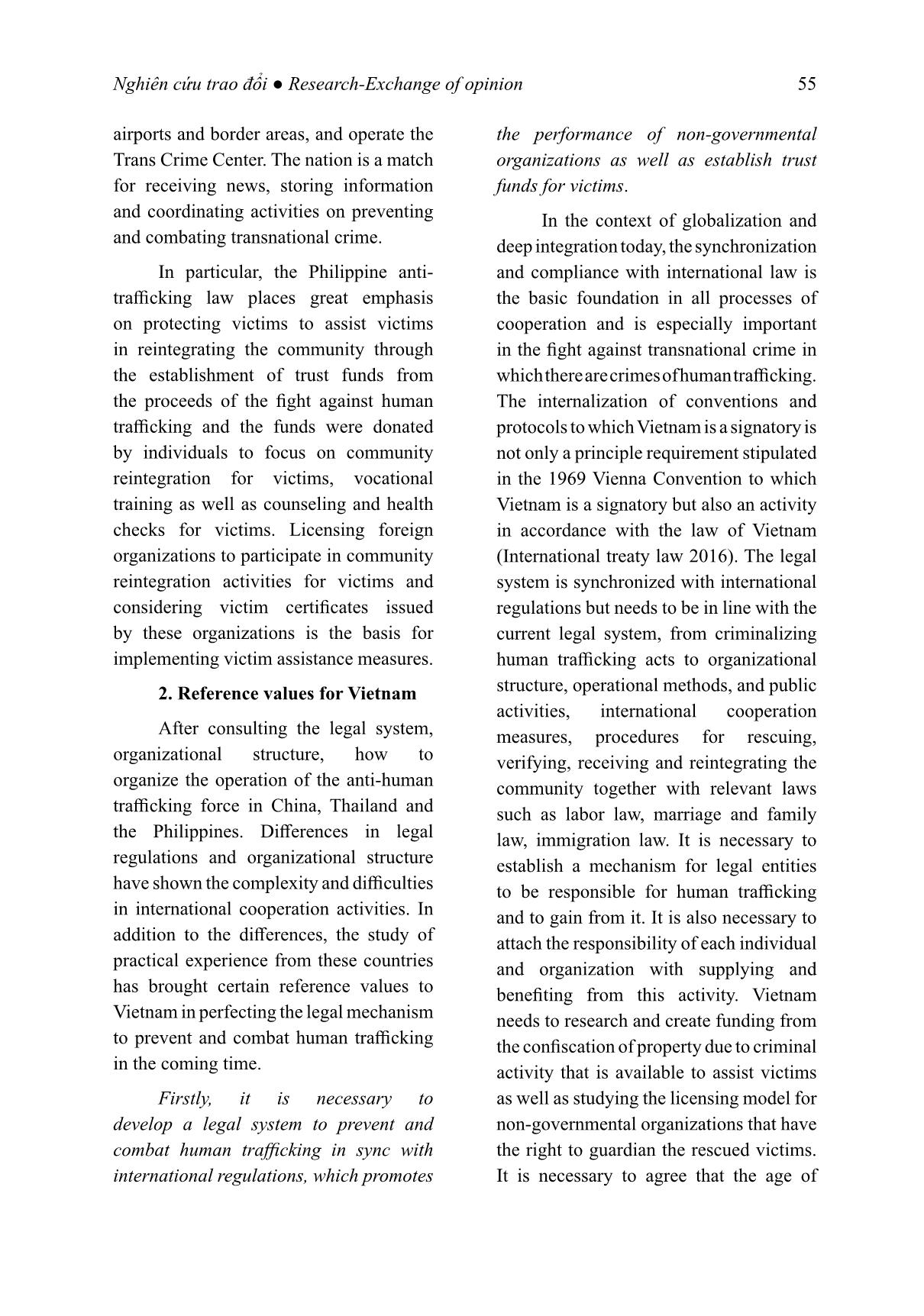
Trang 5
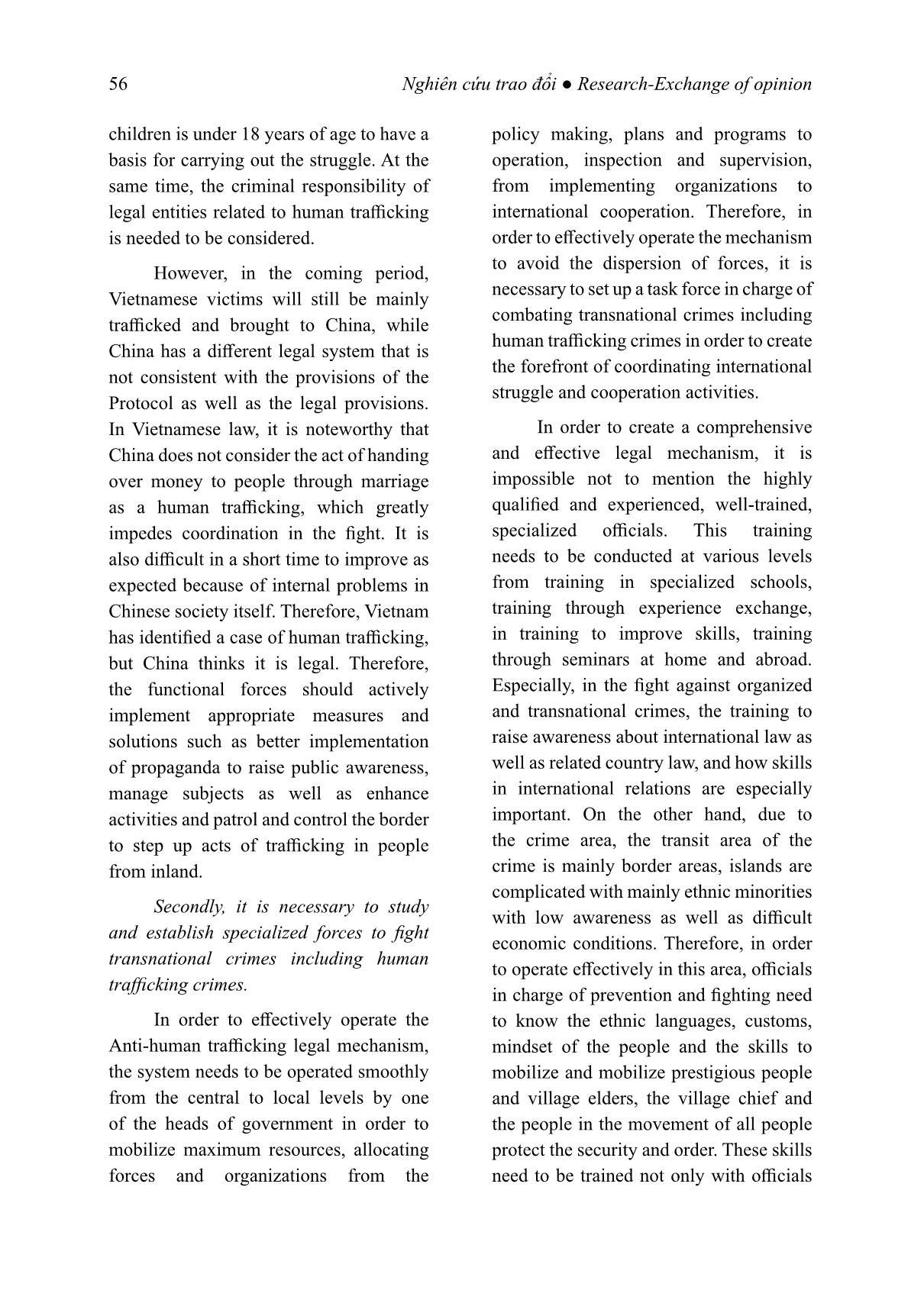
Trang 6
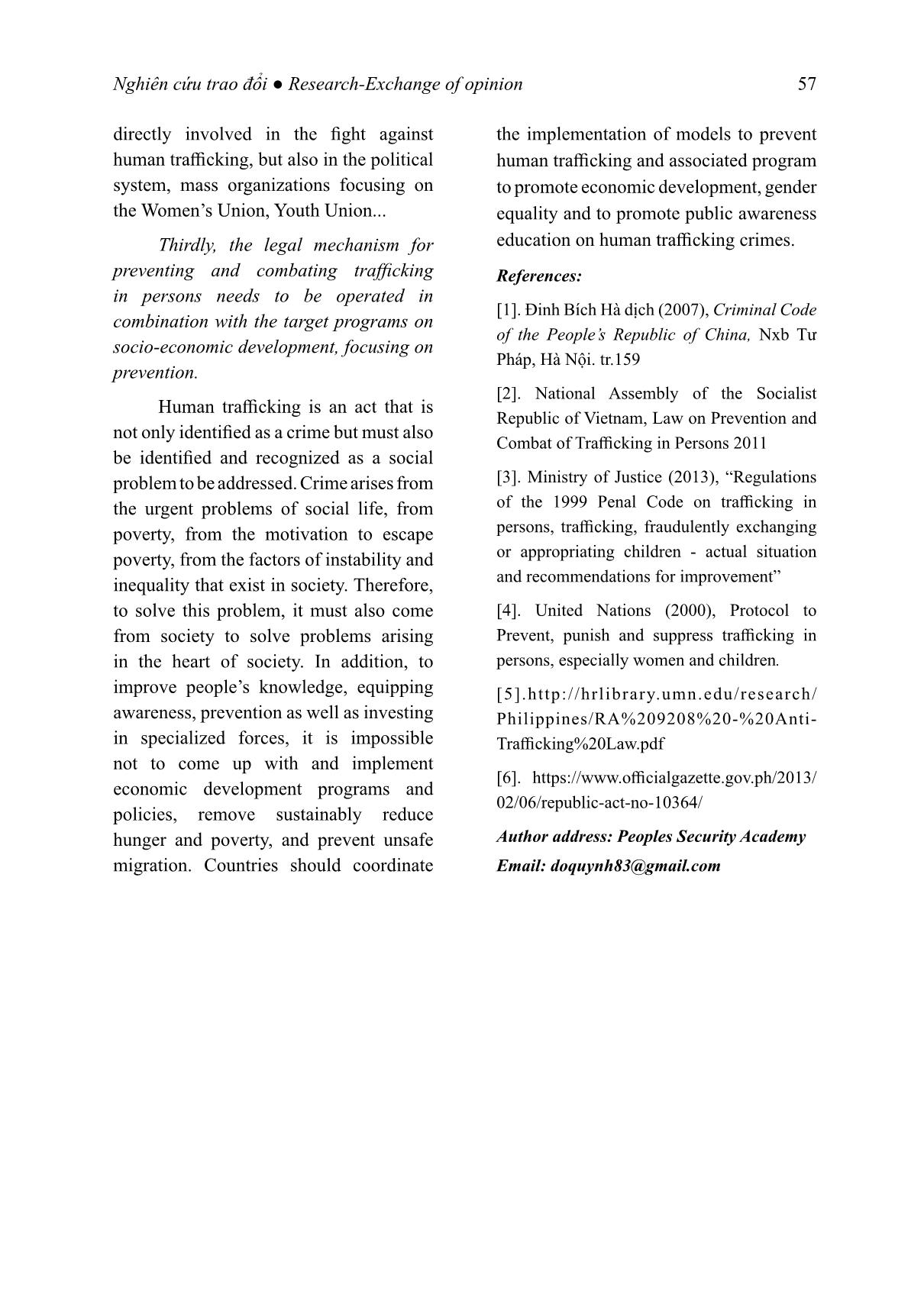
Trang 7
Bạn đang xem tài liệu "International experience in building the legal mechanism for prevention and combat against human trafficking: lessons for Vietnam", để tải tài liệu gốc về máy hãy click vào nút Download ở trên
Tóm tắt nội dung tài liệu: International experience in building the legal mechanism for prevention and combat against human trafficking: lessons for Vietnam
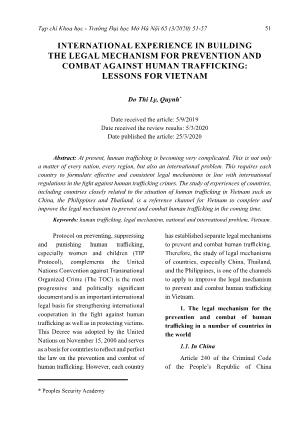
51Nghiên cứu trao đổi ● Research-Exchange of opinion INTERNATIONAL EXPERIENCE IN BUILDING THE LEGAL MECHANISM FOR PREVENTION AND COMBAT AGAINST HUMAN TRAFFICKING: LESSONS FOR VIETNAM Do Thi Ly, Quynh* Date received the article: 5/9/2019 Date received the review results: 5/3/2020 Date published the article: 25/3/2020 Abstract: At present, human traffi cking is becoming very complicated. This is not only a matter of every nation, every region, but also an international problem. This requires each country to formulate eff ective and consistent legal mechanisms in line with international regulations in the fi ght against human traffi cking crimes. The study of experiences of countries, including countries closely related to the situation of human traffi cking in Vietnam such as China, the Philippines and Thailand, is a reference channel for Vietnam to complete and improve the legal mechanism to prevent and combat human traffi cking in the coming time. Keywords: human traffi cking, legal mechanism, national and international problem, Vietnam. * Peoples Security Academy Protocol on preventing, suppressing and punishing human traffi cking, especially women and children (TIP Protocol), complements the United Nations Convention against Transnational Organized Crime (The TOC) is the most progressive and politically signifi cant document and is an important international legal basis for strengthening international cooperation in the fi ght against human traffi cking as well as in protecting victims. This Decree was adopted by the United Nations on November 15, 2000 and serves as a basis for countries to refl ect and perfect the law on the prevention and combat of human traffi cking. However, each country has established separate legal mechanisms to prevent and combat human traffi cking. Therefore, the study of legal mechanisms of countries, especially China, Thailand, and the Philippines, is one of the channels to apply to improve the legal mechanism to prevent and combat human traffi cking in Vietnam. 1. The legal mechanism for the prevention and combat of human traffi cking in a number of countries in the world 1.1. In China Article 240 of the Criminal Code of the People’s Republic of China Tạp chí Khoa học - Trường Đại học Mở Hà Nội 65 (3/2020) 51-57 52 Nghiên cứu trao đổi ● Research-Exchange of opinion 1997 stipulates penalties for each act of traffi cking in women and children, including the highest penalty up to the death penalty and confi scation of all property of criminal objects. However, at present, China only considers sexual exploitation, forced labor and organ harvesting as human traffi cking without considering the act of handing over people and receiving money through marriage as human traffi cking. While China’s main need is to buy and sell brides to address the shortage of women in the country. This is also a diffi culty in coordinating as well as preventing human traffi cking from Vietnam. In addition, as for the Chinese law, Article 241 of the Penal Code, also stipulates that the act of buying women and children for sale is subject to a 3-year penalty, labor re-education or probation. But if they do not prevent them from returning to their former residence according to their wishes, without abusing children who are traffi cked, or preventing their escape eff orts, they may not be prosecuted for criminal liability. Article 242 provides for acts of using violence or intimidation to prevent state offi cials from delivering women and children to be sold. Article 416 stipulates the responsibility of employees in state agencies to rescue women and children. Failure to deliver the rescue will result in up to 5 years of imprisonment or re- education. If the rescue is prevented, the off ender will be sentenced to between 2 and 7 years of imprisonment or re- education. Thus, it is clear that although the legal provisions on traffi cking in women and children are quite heavy with the highest penalty of death penalty, this provision is still fundamentally diff erent from the protocol in both acts, method and purpose. In addition, Chinese law is fl awed when men are not mentioned as victims and China, despite being a destination for traffi cking crimes and complicated human traffi cking acts in the country, China still has no anti-human traffi cking law as other countries in the region and Chinese managers often develop plans and plans to prevent and combat human traffi cking through each stage and now is the period 2013-2020. Minors under Chinese law are under 18 years’ old 1.2. In Thailand Thailand has enacted a Law on Prevention and Combat of Human Traffi cking since 2008, which includes 57 articles which outline the concept of human traffi cking, the level of penalties specifi c to each act, victim assistance and national cooperation as well as establishing an Anti-Traffi cking Committee and a human traffi cking fund. Thailand’s defi nition of human traffi cking is similar to the Protocol’s defi nition of recruiting, transporting, harboring, traffi cking, transferring the same methods as coercion, kidnapping, deceiving, using force and emphasizing exploitation. Regarding punishment, Thai law stipulates penalties based on the age of the victim as well as the object of the off ense. As follows: 53Nghiên cứu trao đổi ● Research-Exchange of opinion Trading people who are imprisoned from 4 to 10 years, fi ned from 56 million to 140 million dongs (converted into Vietnam dongs); Victims from 15 - 18 years old: imprisonment from 6 to 12 years, fi ned from 84 million to 168 million VND; Victims under 15: imprisonment from 8 to 15 years, fi ned from 112 million to 210 million VND. In particular, if the organized crime, the members must face penalties more than 1/2 times the penalty prescribed by law. Bringing victi ... confi scate all of the collected property. Thailand has set up two committees on this issue, the National Committee on Human Traffi cking and the Committee for Coordinating and Monitoring Human Traffi cking Prevention with basic tasks such as: National Committee anti-traffi cking experts are responsible for advising the government on the enactment of laws, organizational structure, and international cooperation. The coordination and supervision committee are responsible for overseeing the implementation of legal policies, overseeing the organization and implementation of tasks, promoting awareness raising and training staff to meet requirements. The National Commission on Human Traffi cking is chaired by the Prime Minister and other ministers are members. The coordination and supervision committee are chaired by the Deputy Prime Minister (the president) and the vice president is the Minister of Human Security and Social Development, operating 1300 hotline 24/7. In addition, Thailand also established a human traffi cking fund from confi scation of property due to traffi cking off enses and the support of societies in order to support victims of human traffi cking. 1.3. In Philippine In September 30, 2003, anti- human traffi cking law - law No. 9208 came into being marking the Philippines’ determination to ensure human rights, prevention and combat human traffi cking. This law sets out the defi nition of human traffi cking in Article 3 - a defi nition quite similar to the defi nition of the Protocol with three signs of behavior, modes and purposes. Defi ne specifi c behaviors from 54 Nghiên cứu trao đổi ● Research-Exchange of opinion introduction, brokerage, abusing marriage contracts, organizing tours, child adoption, and abduction for kidnapping purposes. However, this law also stipulates acts that promote traffi cking in persons (Article 5) such as provision of housing and accommodation; provide fake documents; advertising and printing materials in service of human traffi cking; and it is worth noting that the behavior “intentionally benefi ts fi nancially or otherwise benefi ts from a person’s labor or services in a situation such as slavery, forced or slave labor, or labor exploitation or that service” In Article 6, stipulates that traffi cking acts are considered serious when traffi cking in children; organized crime or with 3 or more victims; The off enders are parents, siblings, and offi cials. Article 7 provides for victim protection and victim information confi dentiality. Article 10 stipulates specifi c penalties: human traffi cking of imprisonment of 20 years, a fi ne of 1-2 million pesos; promoting acts of imprisonment of 15 years and a fi ne of between fi ve hundred thousand and one million pesos; serious human traffi cking off enses will result in life imprisonment and a fi ne of 2-5 million pesos; violations of information security victims are subject to a fi ne of up to 6 years and a fi ne of between fi ve hundred thousand and one million pesos. Violation of Article 6 of penalties can result in life imprisonment, a fi ne of from 2 to 5 million pesos. Violating article 7 of penalties of up to 6 years’ imprisonment, a fi ne of from 500 thousand to 1 million pesos. In addition, the law of the Philippines also specifi es the responsibilities of legal entities of associations, companies, clubs or any legal entity that violates, the company owner, the manager, must also be punished and stripped permanent business license. Or offi cials who do not comply with the provisions of the law will be fi red and end all benefi ts. In particular, Article 11 states that if a victim is used as a victim of sex traffi cking, he / she will be fi ned 6 months of public labor and 50,000 pesos for the fi rst off ense. Second off enses or more will be subject to 1-year imprisonment and 100,000 pesos. In 2012, by law No. 10364, the Philippine government amended and supplemented a number of articles in the law against human traffi cking in 2003, but the core issues mentioned above were not changed. The Act also allows the Philippines to set up an inter-agency committee to combat traffi cking, chaired by the Minister of Justice and the Minister of Welfare and Social Development, responsible for coordinating with all ministries. Other government departments to implement the task of preventing and combating traffi cking in persons, setting up programs, developing laws, supervising, coordinating activities, educating, addressing problems and implementing chapters. reintegration process for victims. In addition, the Philippines has set up task forces to prevent and combat human traffi cking in places at high risk of human traffi cking activities such as harbors, 55Nghiên cứu trao đổi ● Research-Exchange of opinion airports and border areas, and operate the Trans Crime Center. The nation is a match for receiving news, storing information and coordinating activities on preventing and combating transnational crime. In particular, the Philippine anti- traffi cking law places great emphasis on protecting victims to assist victims in reintegrating the community through the establishment of trust funds from the proceeds of the fi ght against human traffi cking and the funds were donated by individuals to focus on community reintegration for victims, vocational training as well as counseling and health checks for victims. Licensing foreign organizations to participate in community reintegration activities for victims and considering victim certifi cates issued by these organizations is the basis for implementing victim assistance measures. 2. Reference values for Vietnam After consulting the legal system, organizational structure, how to organize the operation of the anti-human traffi cking force in China, Thailand and the Philippines. Diff erences in legal regulations and organizational structure have shown the complexity and diffi culties in international cooperation activities. In addition to the diff erences, the study of practical experience from these countries has brought certain reference values to Vietnam in perfecting the legal mechanism to prevent and combat human traffi cking in the coming time. Firstly, it is necessary to develop a legal system to prevent and combat human traffi cking in sync with international regulations, which promotes the performance of non-governmental organizations as well as establish trust funds for victims. In the context of globalization and deep integration today, the synchronization and compliance with international law is the basic foundation in all processes of cooperation and is especially important in the fi ght against transnational crime in which there are crimes of human traffi cking. The internalization of conventions and protocols to which Vietnam is a signatory is not only a principle requirement stipulated in the 1969 Vienna Convention to which Vietnam is a signatory but also an activity in accordance with the law of Vietnam (International treaty law 2016). The legal system is synchronized with international regulations but needs to be in line with the current legal system, from criminalizing human traffi cking acts to organizational structure, operational methods, and public activities, international cooperation measures, procedures for rescuing, verifying, receiving and reintegrating the community together with relevant laws such as labor law, marriage and family law, immigration law. It is necessary to establish a mechanism for legal entities to be responsible for human traffi cking and to gain from it. It is also necessary to attach the responsibility of each individual and organization with supplying and benefi ting from this activity. Vietnam needs to research and create funding from the confi scation of property due to criminal activity that is available to assist victims as well as studying the licensing model for non-governmental organizations that have the right to guardian the rescued victims. It is necessary to agree that the age of 56 Nghiên cứu trao đổi ● Research-Exchange of opinion children is under 18 years of age to have a basis for carrying out the struggle. At the same time, the criminal responsibility of legal entities related to human traffi cking is needed to be considered. However, in the coming period, Vietnamese victims will still be mainly traffi cked and brought to China, while China has a diff erent legal system that is not consistent with the provisions of the Protocol as well as the legal provisions. In Vietnamese law, it is noteworthy that China does not consider the act of handing over money to people through marriage as a human traffi cking, which greatly impedes coordination in the fi ght. It is also diffi cult in a short time to improve as expected because of internal problems in Chinese society itself. Therefore, Vietnam has identifi ed a case of human traffi cking, but China thinks it is legal. Therefore, the functional forces should actively implement appropriate measures and solutions such as better implementation of propaganda to raise public awareness, manage subjects as well as enhance activities and patrol and control the border to step up acts of traffi cking in people from inland. Secondly, it is necessary to study and establish specialized forces to fi ght transnational crimes including human traffi cking crimes. In order to eff ectively operate the Anti-human traffi cking legal mechanism, the system needs to be operated smoothly from the central to local levels by one of the heads of government in order to mobilize maximum resources, allocating forces and organizations from the policy making, plans and programs to operation, inspection and supervision, from implementing organizations to international cooperation. Therefore, in order to eff ectively operate the mechanism to avoid the dispersion of forces, it is necessary to set up a task force in charge of combating transnational crimes including human traffi cking crimes in order to create the forefront of coordinating international struggle and cooperation activities. In order to create a comprehensive and eff ective legal mechanism, it is impossible not to mention the highly qualifi ed and experienced, well-trained, specialized offi cials. This training needs to be conducted at various levels from training in specialized schools, training through experience exchange, in training to improve skills, training through seminars at home and abroad. Especially, in the fi ght against organized and transnational crimes, the training to raise awareness about international law as well as related country law, and how skills in international relations are especially important. On the other hand, due to the crime area, the transit area of the crime is mainly border areas, islands are complicated with mainly ethnic minorities with low awareness as well as diffi cult economic conditions. Therefore, in order to operate eff ectively in this area, offi cials in charge of prevention and fi ghting need to know the ethnic languages, customs, mindset of the people and the skills to mobilize and mobilize prestigious people and village elders, the village chief and the people in the movement of all people protect the security and order. These skills need to be trained not only with offi cials 57Nghiên cứu trao đổi ● Research-Exchange of opinion directly involved in the fi ght against human traffi cking, but also in the political system, mass organizations focusing on the Women’s Union, Youth Union... Thirdly, the legal mechanism for preventing and combating traffi cking in persons needs to be operated in combination with the target programs on socio-economic development, focusing on prevention. Human traffi cking is an act that is not only identifi ed as a crime but must also be identifi ed and recognized as a social problem to be addressed. Crime arises from the urgent problems of social life, from poverty, from the motivation to escape poverty, from the factors of instability and inequality that exist in society. Therefore, to solve this problem, it must also come from society to solve problems arising in the heart of society. In addition, to improve people’s knowledge, equipping awareness, prevention as well as investing in specialized forces, it is impossible not to come up with and implement economic development programs and policies, remove sustainably reduce hunger and poverty, and prevent unsafe migration. Countries should coordinate the implementation of models to prevent human traffi cking and associated program to promote economic development, gender equality and to promote public awareness education on human traffi cking crimes. References: [1]. Đinh Bích Hà dịch (2007), Criminal Code of the People’s Republic of China, Nxb Tư Pháp, Hà Nội. tr.159 [2]. National Assembly of the Socialist Republic of Vietnam, Law on Prevention and Combat of Traffi cking in Persons 2011 [3]. Ministry of Justice (2013), “Regulations of the 1999 Penal Code on traffi cking in persons, traffi cking, fraudulently exchanging or appropriating children - actual situation and recommendations for improvement” [4]. United Nations (2000), Protocol to Prevent, punish and suppress traffi cking in persons, especially women and children. [5].ht tp: / /hrl ibrary.umn.edu/research/ Philippines/RA%209208%20-%20Anti- Traffi cking%20Law.pdf [6]. https://www.offi cialgazette.gov.ph/2013/ 02/06/republic-act-no-10364/ Author address: Peoples Security Academy Email: doquynh83@gmail.com
File đính kèm:
 international_experience_in_building_the_legal_mechanism_for.pdf
international_experience_in_building_the_legal_mechanism_for.pdf

